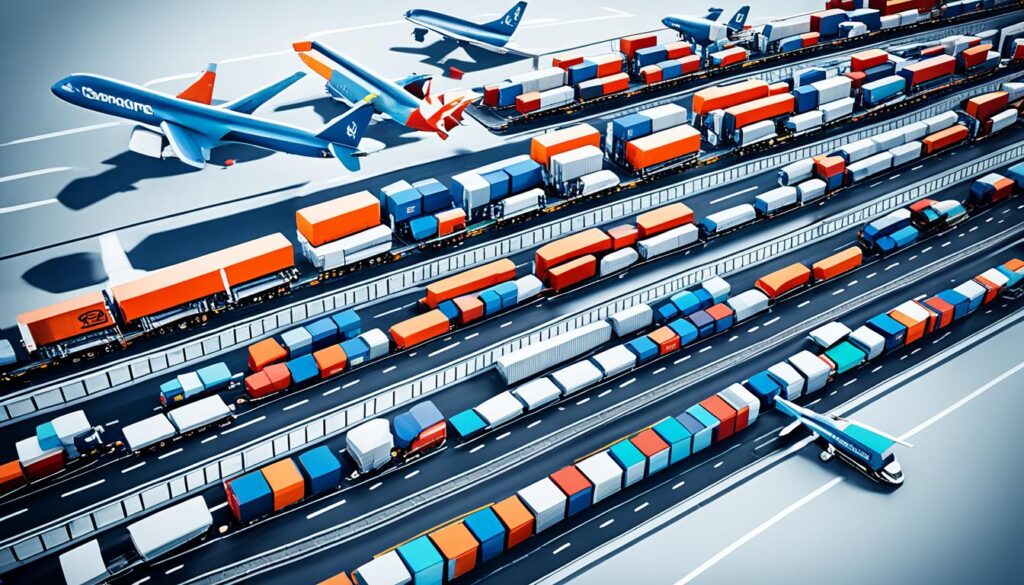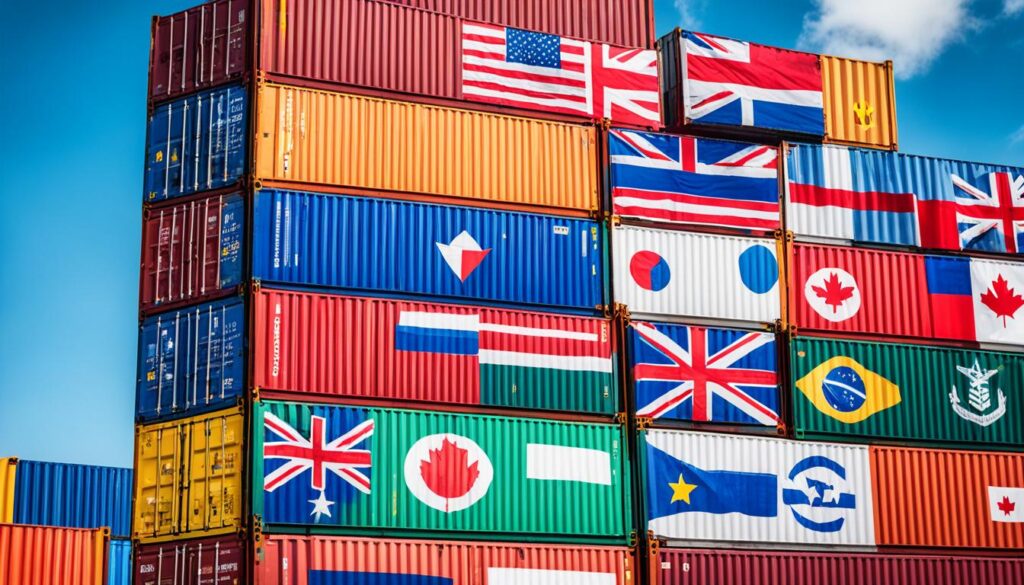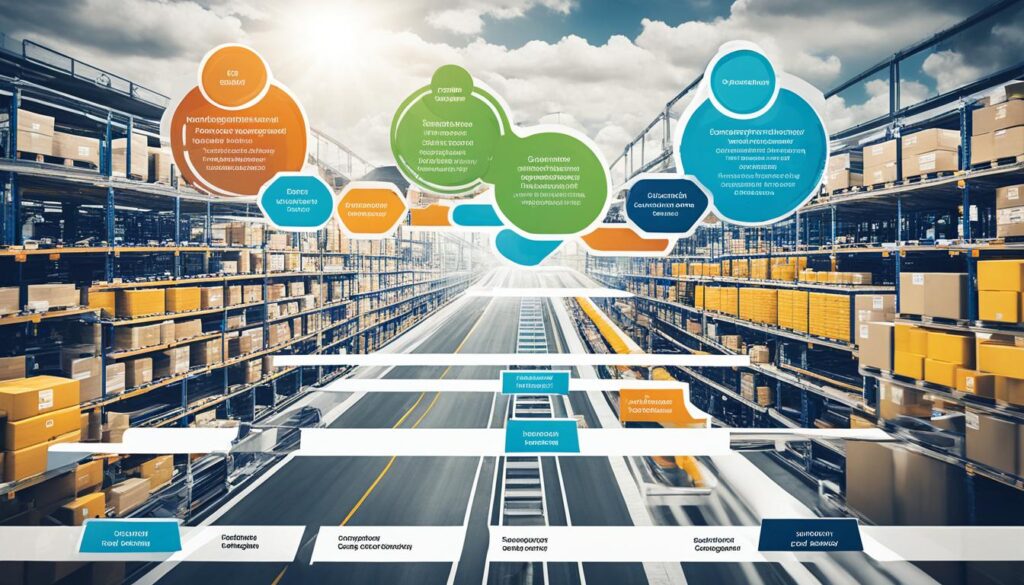As the world becomes increasingly interconnected through international trade, the global supply chain plays a vital role in delivering goods and services across borders. However, managing a global supply chain is not without its challenges. From disruptions to rising costs and regulatory compliance, organizations face numerous obstacles that can impact the efficiency of their operations.
But what if I told you that there are effective strategies to navigate these challenges and optimize logistics management in the global supply chain? What if there are solutions to enhance efficiency and overcome common obstacles?
In this article, I will explore the key challenges faced by organizations in the global supply chain and provide actionable solutions to navigate them successfully. From expanding your supplier network to harnessing technological advancements and implementing safety inventory measures, we will delve into strategies that can help you overcome hurdles and streamline your operations.
Key Takeaways:
- Diversify your supplier network to mitigate the risk of disruptions.
- Enhance communication channels to improve coordination and responsiveness.
- Harness technological advancements for real-time tracking and proactive adjustments.
- Implement safety inventory measures to safeguard against unforeseen delays.
- Negotiate flexible contract arrangements for adaptability during uncertainties.
Expanding Your Supplier Network
To mitigate the risk of disruptions in the global supply chain, it is imperative for organizations to broaden their supplier network. Relying solely on a single supplier can lead to vulnerabilities and challenges if that supplier encounters difficulties. By expanding your supplier network, you can effectively distribute risk and ensure continuity even in the face of unexpected disruptions.
Diversifying your sources within the supply chain network is an essential step in risk mitigation. It allows you to establish relationships with multiple suppliers, reducing the dependency on any single entity. This strategic approach allows you to maintain a steady supply of critical items, minimizing the impact of potential supplier-related disruptions.
When expanding your supplier network, consider sourcing from different geographical locations to further reduce vulnerability to regional disruptions. Cultivating relationships with suppliers across various countries or continents helps safeguard your supply chain from being significantly impacted by localized issues such as natural disasters or political unrest.
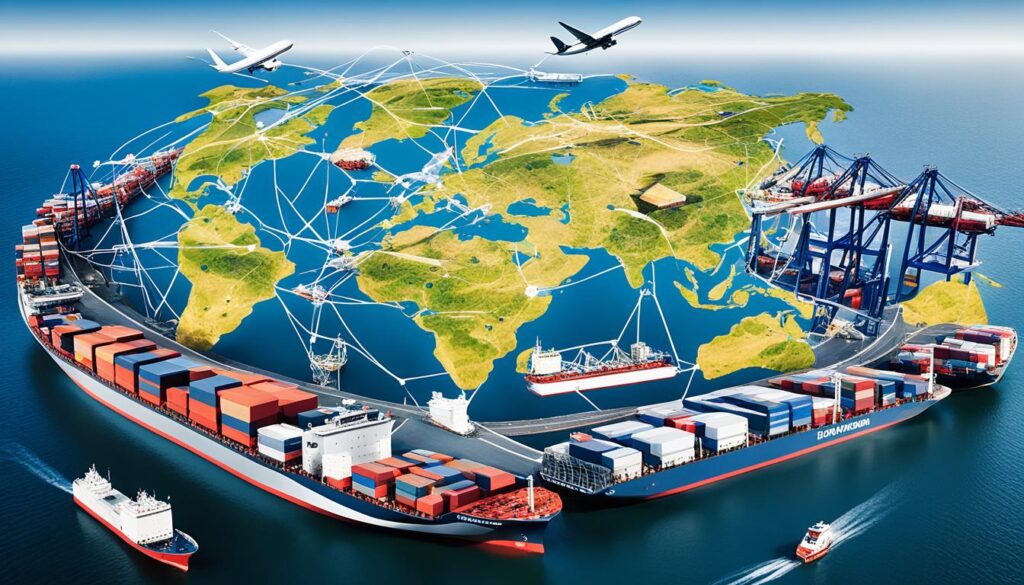
Moreover, having an extensive supplier network provides the opportunity to negotiate better terms and prices with different vendors. By fostering healthy competition between suppliers, you can ensure competitive pricing and quality control, enhancing your overall supply chain efficiency.
Expanding your supplier network is not without its challenges. It requires careful evaluation of potential partners, including their capabilities, reliability, and adherence to ethical and environmental standards. Conduct thorough due diligence to align your organization with trusted suppliers who share your commitment to sustainability and operational excellence.
Benefits of Expanding Your Supplier Network:
- Distribution of risk across multiple sources
- Continuity of operations in the face of disruptions
- Access to a steady supply of critical items
- Reduced vulnerability to supplier-related challenges
- Potential for better terms and pricing through competition
By expanding your supplier network, you can strengthen your global supply chain and improve your ability to navigate unforeseen challenges effectively.
Enhancing Communication Channels
Effective communication is crucial for ensuring operational stability in the global supply chain. By establishing efficient communication channels, organizations can improve coordination, enhance responsiveness, and maintain smooth operations even in the face of challenges. Regular updates among stakeholders enable swift adaptations to potential disruptions and foster collaborative problem-solving.
Benefits of Enhanced Communication Channels
Enhancing communication channels within the global supply chain offers several key advantages:
- Improved Data Sharing: Efficient communication facilitates the seamless exchange of data and information among stakeholders, enabling better decision-making and planning.
- Enhanced Coordination: Regular updates and clear communication channels ensure that everyone involved in the supply chain is aligned with the latest information, enabling smooth coordination and minimizing operational disruptions.
- Swift Adaptability: Effective communication enables organizations to quickly adapt to changes, address potential disruptions, and implement timely solutions, thereby maintaining operational stability.
- Collaborative Problem-Solving: Strong communication channels foster collaboration among stakeholders, allowing for shared insights, innovative solutions, and proactive problem-solving.
Implementing Communication Platforms
To enhance communication channels in the global supply chain, organizations can leverage modern communication platforms that offer real-time connectivity and collaboration. These platforms enable stakeholders to exchange information, track progress, share updates, and collaborate on resolving issues.
By leveraging communication platforms, organizations can establish a central hub for effective communication, ensuring that all stakeholders have access to the latest information, making informed decisions, and fostering operational stability.
Ensuring Clarity and Transparency
Clear and transparent communication is essential for maintaining operational stability in the global supply chain. To achieve this, organizations should:
- Establish Clear Communication Protocols: Define and communicate guidelines for sharing information, reporting updates, and resolving communication-related issues to ensure consistency across the supply chain.
- Promote Open Dialogue: Encourage stakeholders to ask questions, raise concerns, and contribute ideas, fostering a culture of open communication and collaboration.
- Provide Visual Communication Tools: Utilize visual aids such as charts, diagrams, and graphs to convey complex information more effectively and enhance understanding among stakeholders.
Case Study: Implementing a Global Communication Platform
In 2019, ABC Corporation, a global manufacturing company, implemented a comprehensive communication platform to enhance collaboration and operational stability in their global supply chain.
The platform facilitated real-time communication among suppliers, logistics partners, and internal teams, enabling seamless information sharing and rapid decision-making. It included features such as instant messaging, document sharing, video conferencing, and project management tools.
By leveraging this communication platform, ABC Corporation experienced improved coordination, faster problem resolution, and enhanced responsiveness to disruptions. The platform’s centralized nature ensured that stakeholders had access to the same information simultaneously, eliminating communication gaps and reducing operational delays.
| Benefits of Enhanced Communication Channels | Implementing Communication Platforms | Ensuring Clarity and Transparency |
|---|---|---|
| Improved data sharing | Establish a central hub for effective communication | Establish clear communication protocols |
| Enhanced coordination | Real-time connectivity and collaboration | Promote open dialogue |
| Swift adaptability | Provide visual communication tools | |
| Collaborative problem-solving |
Harnessing Technological Advancements
Technology plays a vital role in optimizing the global supply chain. By leveraging real-time shipment tracking and data analytics, organizations can anticipate and mitigate operational delays. Embracing technological advancements empowers proactive adjustments, enabling organizations to preempt disruptions and maintain a seamless supply chain.
In today’s interconnected world, real-time tracking has become essential for effective supply chain management. With innovative technologies, organizations have access to precise information about the location and status of their shipments. This level of visibility allows for better planning and coordination, reducing the risk of operational delays.
Real-time tracking enables organizations to identify potential issues as they arise, facilitating prompt action to address them. Whether it’s rerouting shipments to avoid bottlenecks or reallocating resources to ensure on-time deliveries, real-time tracking empowers organizations to make data-driven decisions that optimize their supply chain operations.
“Real-time tracking provides valuable insights into the movement of goods throughout the supply chain. By knowing exactly where shipments are and proactively managing any deviations, organizations can minimize the impact of operational delays and ensure customer satisfaction.” – Supply Chain Manager at XYZ Corporation
Data analytics is another technological advancement that revolutionizes the supply chain industry. By analyzing large volumes of data, organizations can gain valuable insights to optimize their operations and improve decision-making. Data analytics allows for proactive measures to be taken to mitigate potential operational delays and ensure a smooth supply chain flow.
For example, predictive analytics can help identify patterns and trends that may result in delays. By leveraging this information, organizations can take proactive measures to prevent such delays from occurring. They can adjust production schedules, optimize inventory levels, and proactively address potential bottlenecks in the supply chain.
Moreover, data analytics can also enhance collaboration and communication among supply chain partners. By sharing relevant data and insights, organizations can foster meaningful partnerships and drive collective improvements in efficiency and operational performance.
Benefits of Harnessing Technological Advancements:
- Improved visibility and traceability of shipments
- Proactive identification and mitigation of operational delays
- Efficient resource allocation and capacity planning
- Enhanced decision-making through data-driven insights
- Collaborative and cooperative supply chain partnerships
In conclusion, harnessing technological advancements such as real-time tracking and data analytics is crucial for optimizing the global supply chain. By embracing these advancements, organizations can anticipate and mitigate operational delays, ensuring a seamless flow of goods and services. The use of technology not only enhances operational efficiency but also enables organizations to remain agile and adaptable in the face of ever-changing supply chain challenges.
![]()
Implementing Safety Inventory Measures
Allocating additional inventory capacity acts as a safeguard against unforeseen delays in the global supply chain. By maintaining safety inventory levels, organizations can prevent shortages of critical supplies or products. This precautionary measure ensures continuous operations, even when faced with unexpected disruptions.
Unforeseen delays can arise due to various factors such as natural disasters, transportation issues, or production challenges. Without safety inventory, organizations may face significant disruptions, impacting their ability to meet customer demands and maintain operational efficiency. By implementing safety inventory measures, organizations can mitigate the risks associated with unforeseen delays and ensure the availability of critical supplies.
Safety inventory is the buffer stock maintained by organizations to compensate for uncertainties in demand and supply. It helps organizations meet unexpected surges in demand or compensate for supplier delays. By strategically placing safety inventory at key locations along the supply chain, organizations can improve responsiveness and quickly address disruptions.
Implementing safety inventory measures involves careful planning and analysis of historical demand patterns, lead times, and supplier reliability. Organizations need to identify critical supplies, estimate potential demand fluctuations, and set appropriate inventory levels to meet customer expectations.
In addition to ensuring continuity of operations, safety inventory can also provide other benefits. It allows organizations to take advantage of economies of scale by ordering larger quantities, thereby reducing unit costs. Safety inventory can also serve as a buffer during periods of increased demand or supply chain volatility.
However, maintaining safety inventory comes with its own challenges. Organizations need to strike a balance between holding enough inventory to mitigate disruptions and minimizing carrying costs. Excessive inventory levels can tie up capital and lead to increased warehousing and handling costs.
Effective inventory management practices, such as just-in-time (JIT) inventory systems and demand forecasting, can help optimize safety inventory levels. By adopting advanced inventory management tools and techniques, organizations can achieve the right balance between inventory costs and risk mitigation.
Benefits of Implementing Safety Inventory Measures:
- Ensures continuous operations in the event of unforeseen delays
- Prevents shortages of critical supplies or products
- Improves responsiveness and reduces lead times
- Enables organizations to meet unexpected surges in demand
- Provides a buffer during periods of increased supply chain volatility
Implementing safety inventory measures is an essential component of supply chain risk management. It allows organizations to navigate disruptions and maintain the smooth flow of critical supplies. By adopting proactive inventory management strategies, organizations can enhance their resilience and ensure customer satisfaction even in challenging circumstances.
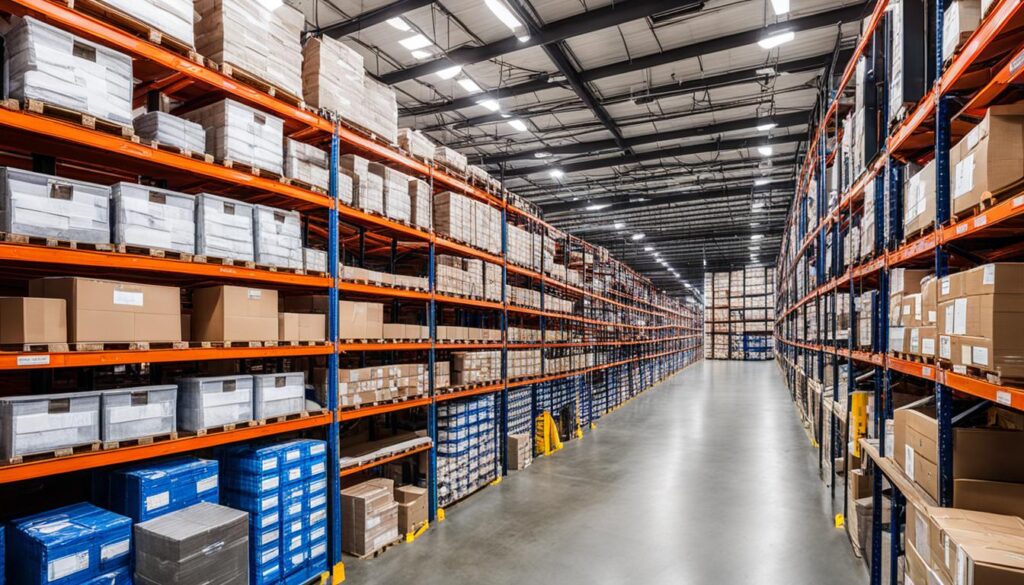
Negotiating Flexible Contract Arrangements
In times of uncertainty, organizations should prioritize adaptability by negotiating flexible contract arrangements with partners. Flexible contracts allow for adjustments in quantities, timelines, and payment conditions during disruptions, ensuring a seamless flow in the global supply chain.
When faced with unexpected challenges, such as changes in market demand or supply interruptions, organizations can rely on flexible contract terms to swiftly adapt their operations. By fostering flexibility, organizations can minimize the impact on the global supply chain and maintain stability in their operations.
Adapting Quantities
Flexible contracts offer the advantage of adapting quantities based on changing circumstances. For example, if there is a sudden decrease in demand, organizations can reduce their order volumes to prevent inventory buildup and optimize resource allocation. On the other hand, when demand spikes unexpectedly, organizations can increase their orders to meet customer needs.
Adjusting Timelines
The global supply chain can be subject to various delays and disruptions, ranging from logistical challenges to unforeseen events. Flexible contracts allow for adjusting timelines to accommodate these disruptions. For instance, if there are delays in production or shipping, organizations can modify delivery schedules to ensure timely receipt of goods.
Modifying Payment Conditions
During periods of uncertainty, cash flow management becomes crucial. Flexible contracts empower organizations to negotiate payment conditions that align with their financial capabilities. This may include adjusting payment terms, exploring installment options, or implementing alternative payment methods to mitigate financial strains and maintain healthy supplier relationships.
“Flexible contract arrangements enable organizations to swiftly adapt to changing circumstances and overcome supply chain disruptions.” – John Masters, Supply Chain Director at ABC Corporation
In summary, negotiating flexible contract arrangements is an essential strategy for organizations aiming to enhance adaptability in the global supply chain. By allowing adjustments in quantities, timelines, and payment conditions, flexible contracts enable organizations to minimize the impact of disruptions and maintain operational stability. Adaptability is key in navigating the challenges of the global supply chain, and flexible contracts play a vital role in fostering this adaptability.

Forging Collaborative Partnerships
Building strong and collaborative partnerships is crucial for navigating challenges in the global supply chain. By fostering cohesive relationships with logistics providers, organizations can tap into their expertise and resources, enhancing the overall resilience of the supply chain. Collaborative partnerships promote knowledge sharing and the adoption of best practices, enabling organizations to stay at the forefront of industry trends and developments. These partnerships create a network of allies that provide mutual support and diverse perspectives, enabling organizations to proactively address challenges and find innovative solutions.
Collaborative partnerships drive the exchange of ideas and knowledge, facilitating the optimization of operations within the global supply chain. By sharing insights and experiences, organizations can identify valuable strategies and techniques for enhancing efficiency and mitigating risks. Furthermore, these partnerships foster open lines of communication, enabling organizations to proactively address potential disruptions and cooperatively develop contingency plans.
“Collaboration is the key to unlocking the full potential of the global supply chain. By working together, organizations can leverage their respective strengths, share knowledge, and drive innovation.”
– John Smith, CEO of Global Logistics Solutions
Benefits of Collaborative Partnerships
Collaborative partnerships offer a range of benefits for organizations operating in the global supply chain:
- Reduced Risk: Collaborative partnerships help diversify risks by distributing responsibilities and resources among multiple stakeholders. This reduces reliance on a single entity and minimizes the impact of disruptions on the supply chain.
- Access to Expertise: Partnering with experienced logistics providers provides organizations with access to specialized knowledge and industry insights. This allows for better decision-making and optimization of supply chain processes.
- Cost Savings: Collaborative partnerships can lead to cost savings through shared resources, pooled volumes, and joint investments in infrastructure and technologies. This allows organizations to achieve economies of scale and enhance operational efficiency.
- Innovation and Continuous Improvement: Through knowledge sharing and collaboration, organizations can foster a culture of innovation and continuous improvement. By learning from each other’s experiences and experimenting with new approaches, partners can drive positive change in the supply chain.
| Benefits of Collaborative Partnerships | Explanation |
|---|---|
| Reduced Risk | Collaborative partnerships distribute responsibilities and resources, minimizing the impact of disruptions. |
| Access to Expertise | Partnerships provide access to specialized knowledge and industry insights, enabling better decision-making. |
| Cost Savings | Shared resources and pooled volumes lead to cost savings and operational efficiency. |
| Innovation and Continuous Improvement | Collaborative partnerships foster a culture of innovation and drive positive change in the supply chain. |
By forging collaborative partnerships, organizations can leverage the collective strength and expertise of their partners to overcome challenges and achieve operational excellence in the global supply chain.

Staying Vigilant and Informed
In the global supply chain, effective risk management and informed decision-making are paramount to ensuring the smooth flow of operations and mitigating potential disruptions. By staying vigilant and well-informed about global events, weather dynamics, and geopolitical landscapes, organizations can proactively identify and address potential risks, enabling them to make informed decisions and take necessary precautions.
Remaining up-to-date with global events allows organizations to anticipate potential disruptions that may impact the global supply chain. Whether it’s geopolitical tensions, natural disasters, or economic fluctuations, being aware of these factors empowers organizations to develop contingency plans and respond swiftly and effectively.
Weather dynamics can significantly impact transportation routes, port operations, and overall logistics in the global supply chain. By monitoring weather forecasts and patterns, organizations can anticipate potential delays or disruptions and take appropriate measures to minimize their impact.
Understanding geopolitical landscapes and changes in trade policies is vital for sound decision-making in the global supply chain. By staying informed about trade agreements, tariffs, embargoes, and political developments, organizations can proactively adjust their strategies, assess potential risks, and explore alternative supply chain routes or sourcing options.
“Staying informed about global events, weather dynamics, and geopolitical landscapes enables organizations to anticipate potential risks, make informed decisions, and take necessary precautions.”
To enhance their vigilance and information-gathering capabilities, organizations can leverage various resources. Following industry-specific news sources, participating in trade associations, and engaging in knowledge-sharing platforms create opportunities for organizations to exchange insights, best practices, and early warnings about potential risks.
Additionally, technological advancements in real-time data analytics and supply chain management systems enable organizations to gather valuable insights and monitor the global supply chain more effectively. By leveraging these tools, organizations can track key performance indicators, detect patterns, and identify potential risks or areas for improvement.
Ultimately, staying vigilant and informed empowers organizations to make informed decisions and take proactive measures to address potential disruptions. By continuously monitoring global events, weather dynamics, and geopolitical landscapes, organizations can navigate the global supply chain with resilience, agility, and efficiency.
Contingency Planning
When it comes to the global supply chain, organizations must be prepared for unforeseen disruptions. That’s where contingency planning plays a crucial role. By developing pre-planned responses for diverse scenarios, organizations can minimize disruptions and ensure a quick and efficient recovery.
Contingency planning involves identifying potential risks and creating strategies to mitigate their impact on the global supply chain. It requires careful analysis of various factors, including supplier dependencies, transportation disruptions, natural disasters, and geopolitical risks. By anticipating these challenges and having contingency plans in place, organizations can navigate through them with minimal disruptions to operations.
One of the key advantages of contingency planning is that it allows organizations to respond promptly to disruptions. Instead of scrambling to come up with a solution in the midst of a crisis, pre-planned responses provide a clear roadmap to follow. This enables organizations to act swiftly and decisively, minimizing downtime and reducing the negative impact on the global supply chain.
Moreover, contingency planning enhances risk management efforts. By anticipating potential disruptions and developing strategies to address them, organizations can proactively manage risks and ensure operational stability. This helps in avoiding costly delays, product shortages, and customer dissatisfaction.
Successful contingency planning requires collaboration and coordination among different stakeholders in the global supply chain. It is essential to involve suppliers, logistics partners, and other key players to ensure that everyone is aligned and prepared to execute the pre-planned responses effectively.
Overall, contingency planning is a proactive approach to managing risks and uncertainties in the global supply chain. By having well-defined strategies and pre-planned responses in place, organizations can navigate challenges with greater ease and maintain a resilient supply chain.
Building Resilience as an Ongoing Process
Building resilience in the global supply chain is a continuous endeavor that requires organizations to implement strategic measures and remain adaptable in the face of challenges. The ever-evolving nature of the global marketplace demands a proactive approach to ensure operational robustness and maintain a competitive edge.
Resilience entails the ability to withstand disruptions, adapt to changing circumstances, and swiftly recover from setbacks. By continuously evaluating and enhancing their operations, organizations can fortify their ability to respond effectively to unforeseen events that can impact the global supply chain.
Implementing Risk Mitigation Strategies
One fundamental aspect of building resilience is implementing risk mitigation strategies. This involves identifying potential risks, assessing their impact on the supply chain, and developing proactive measures to mitigate their effects.
For example, organizations can adopt a diversified sourcing approach, reducing dependence on a single supplier or geographic region. By establishing multiple supplier relationships, organizations can create a more resilient supply chain that can withstand disruptions such as natural disasters, geopolitical crises, or trade restrictions.
“Diversifying our supplier network has enabled us to minimize the impact of disruptions and maintain a steady supply of critical items. This approach has proven invaluable in navigating the challenges of the global supply chain.”
– John Smith, Supply Chain Manager at XYZ Corporation
Fostering Adaptability and Collaboration
Adaptability is essential in a rapidly changing global supply chain landscape. Organizations need to foster a culture of adaptability that encourages employees to remain flexible, innovative, and open to new ideas and approaches.
Collaboration plays a crucial role in building resilience. By forging strong partnerships with suppliers, logistics providers, and other stakeholders, organizations can leverage collective knowledge and resources to overcome challenges. Sharing best practices, insights, and industry trends can help develop proactive strategies that enhance the resilience of the entire supply chain ecosystem.
Investing in Technology and Data Analytics
Technology and data analytics play a vital role in building resilience in the global supply chain. Implementing advanced tracking systems, real-time data analytics, and predictive modeling tools can provide organizations with the visibility and insights necessary to make informed decisions and take proactive measures.
By leveraging technology, organizations can monitor supply chain performance, identify potential bottlenecks, and pre-emptively address emerging issues. This enables faster response times, efficient resource allocation, and optimized decision-making that enhances the overall resilience and adaptability of the global supply chain.
Continual Evaluation and Improvement
Building resilience in the global supply chain is not a one-time effort but an ongoing process. Organizations must continuously evaluate their operations, measure performance metrics, and seek opportunities for improvement.
Periodic assessments help identify areas of weakness and potential vulnerabilities in the supply chain. By analyzing data, conducting risk assessments, and implementing corrective measures, organizations can enhance their resilience, ensuring that they remain agile and capable of navigating future challenges.
The journey towards building resilience in the global supply chain requires a proactive mindset, strategic investments, and a commitment to continuous improvement. By implementing risk mitigation strategies, fostering adaptability and collaboration, investing in technology and data analytics, and embracing a culture of continual evaluation and improvement, organizations can enhance their resilience and adaptability, positioning themselves for success in an ever-changing global marketplace.
Overcoming Supply Chain Challenges
Managing a global supply chain involves addressing various challenges that can hinder efficiency and disrupt operations. These challenges arise from factors such as:
- Disruptions
- Lack of visibility
- Demand uncertainty
- Rising costs
- Labor shortages
- Geopolitical risks
- Cybersecurity threats
- Customer expectations
- Regulatory compliance
To mitigate these challenges and enhance the efficiency of the global supply chain, organizations need to implement effective risk mitigation strategies. By following the strategies discussed earlier in this article and staying proactive, organizations can overcome these challenges and ensure smooth operations.
Implementing risk mitigation strategies such as diversifying the supplier network, enhancing communication channels, harnessing technological advancements, implementing safety inventory measures, negotiating flexible contract arrangements, forging collaborative partnerships, and staying informed about global events, organizations can build resilience and minimize the impact of supply chain challenges.
“By implementing risk mitigation strategies and staying proactive, organizations can navigate supply chain challenges and enhance the efficiency of their global operations.”
It is important for organizations to recognize that supply chain challenges are an ongoing part of managing a global supply chain. By continuously evaluating and adapting strategies, organizations can effectively navigate these challenges and optimize their supply chain processes. Proactive planning, data-driven decision-making, and a commitment to innovation are key to maintaining a resilient and efficient global supply chain.
Strategies for Overcoming Supply Chain Challenges
| Challenge | Risk Mitigation Strategies |
|---|---|
| Disruptions | Diversify supplier network, develop contingency plans |
| Lack of visibility | Enhance data integration and real-time tracking systems |
| Demand uncertainty | Implement demand forecasting and agile planning |
| Rising costs | Optimize procurement processes and explore cost-saving initiatives |
| Labor shortages | Invest in workforce development and automation |
| Geopolitical risks | Monitor geopolitical landscapes and diversify sourcing |
| Cybersecurity threats | Implement robust cybersecurity measures and regular audits |
| Customer expectations | Focus on personalized service and fast order fulfillment |
| Regulatory compliance | Stay informed about regulatory changes and ensure compliance |
By addressing these challenges through a combination of proactive risk management strategies and an agile mindset, organizations can optimize their global supply chains and build a competitive advantage in the ever-evolving business landscape.
Conclusion
Navigating challenges in the global supply chain requires a multifaceted approach. By implementing strategies such as expanding your supplier network, enhancing communication channels, harnessing technological advancements, implementing safety inventory measures, negotiating flexible contract arrangements, forging collaborative partnerships, staying vigilant and informed, developing contingency plans, and continuously building resilience, organizations can enhance the efficiency and effectiveness of their global supply chains.
To ensure a robust global supply chain, it is essential for organizations to adapt to the ever-evolving landscape and proactively address challenges. By doing so, they can overcome disruptions, increase operational efficiency, and maintain a seamless flow of goods and services. The key is to leverage solutions that optimize logistics management, mitigate risks, and improve overall supply chain performance.
Organizations must stay proactive and continually evaluate their operations to identify areas for improvement. By addressing specific challenges such as disruptions, lack of data visibility, demand uncertainty, rising costs, labor shortages, geopolitical risks, cybersecurity threats, customer expectations, and regulatory compliance, organizations can strengthen their global supply chains. Embracing innovation, collaboration, and knowledge sharing will further enhance their resilience in the face of uncertainty.
